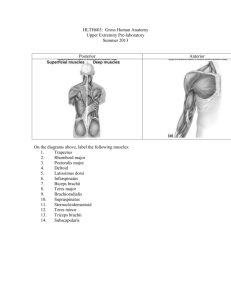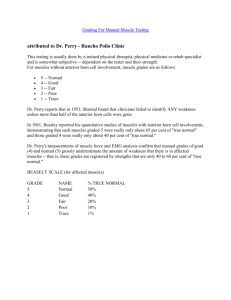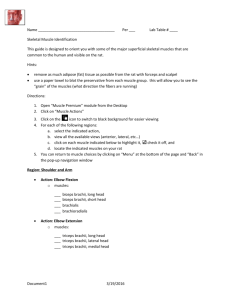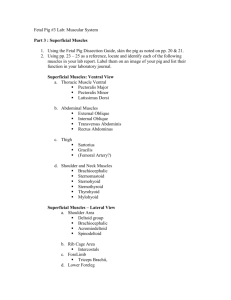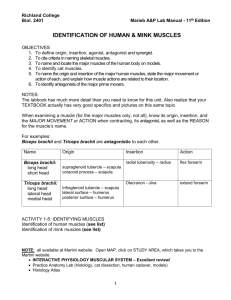Name: Date: Title: Observing the Muscular System Objective: Name
advertisement
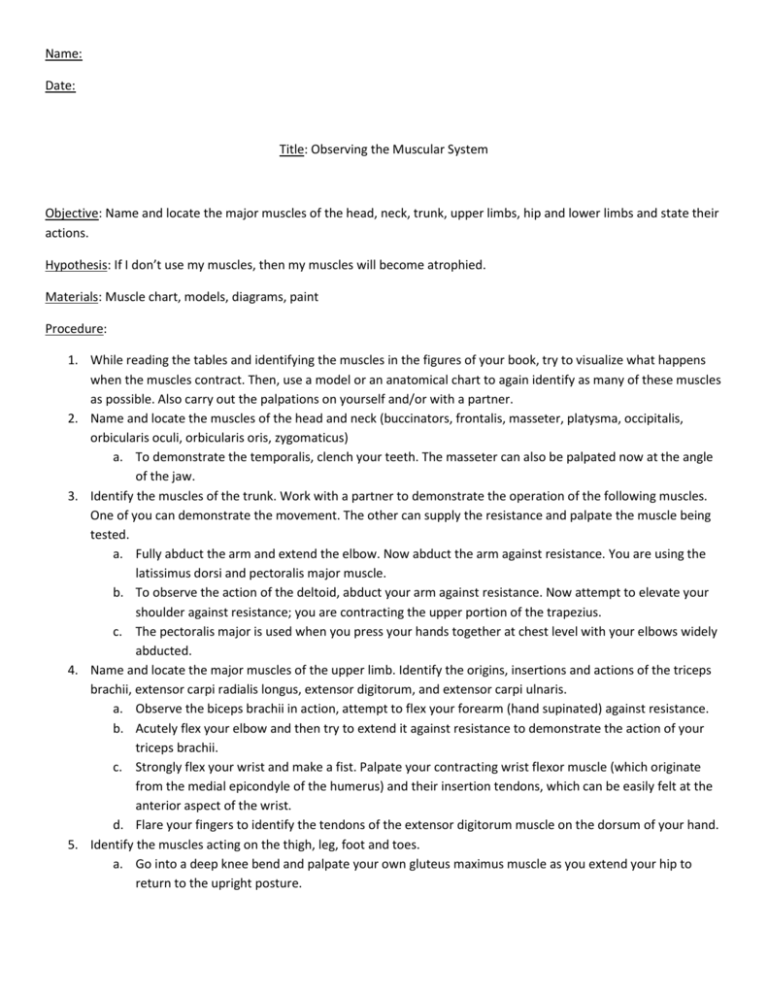
Name: Date: Title: Observing the Muscular System Objective: Name and locate the major muscles of the head, neck, trunk, upper limbs, hip and lower limbs and state their actions. Hypothesis: If I don’t use my muscles, then my muscles will become atrophied. Materials: Muscle chart, models, diagrams, paint Procedure: 1. While reading the tables and identifying the muscles in the figures of your book, try to visualize what happens when the muscles contract. Then, use a model or an anatomical chart to again identify as many of these muscles as possible. Also carry out the palpations on yourself and/or with a partner. 2. Name and locate the muscles of the head and neck (buccinators, frontalis, masseter, platysma, occipitalis, orbicularis oculi, orbicularis oris, zygomaticus) a. To demonstrate the temporalis, clench your teeth. The masseter can also be palpated now at the angle of the jaw. 3. Identify the muscles of the trunk. Work with a partner to demonstrate the operation of the following muscles. One of you can demonstrate the movement. The other can supply the resistance and palpate the muscle being tested. a. Fully abduct the arm and extend the elbow. Now abduct the arm against resistance. You are using the latissimus dorsi and pectoralis major muscle. b. To observe the action of the deltoid, abduct your arm against resistance. Now attempt to elevate your shoulder against resistance; you are contracting the upper portion of the trapezius. c. The pectoralis major is used when you press your hands together at chest level with your elbows widely abducted. 4. Name and locate the major muscles of the upper limb. Identify the origins, insertions and actions of the triceps brachii, extensor carpi radialis longus, extensor digitorum, and extensor carpi ulnaris. a. Observe the biceps brachii in action, attempt to flex your forearm (hand supinated) against resistance. b. Acutely flex your elbow and then try to extend it against resistance to demonstrate the action of your triceps brachii. c. Strongly flex your wrist and make a fist. Palpate your contracting wrist flexor muscle (which originate from the medial epicondyle of the humerus) and their insertion tendons, which can be easily felt at the anterior aspect of the wrist. d. Flare your fingers to identify the tendons of the extensor digitorum muscle on the dorsum of your hand. 5. Identify the muscles acting on the thigh, leg, foot and toes. a. Go into a deep knee bend and palpate your own gluteus maximus muscle as you extend your hip to return to the upright posture. b. Demonstrate the contraction of the anterior quadriceps femoris by trying to extend your knee against resistance. Do this while seated and notice how the patellar tendon reacts. The hamstring of the posterior thigh come into play when you flex your knee against resistance. c. Now stand on your toes. Have your partner palpate the lateral and medial head of the gastrocnemius and follow it to its insertion in the calcaneal tendon. d. Dorsiflex and invert your foot while palpating your tibialis anterior muscle (which parallels the sharp anterior crest of the tibia laterally). 6. Human muscle painting…Obtain brushes and water-based paints (whatever your teacher has supplied). a. Have “volunteers” roll up their sleeves and pant legs (you were instructed to wear shorts and tank tops today). Using different colored paints provided… identify the muscles listed below by painting the skin. If the muscle covers a large body area, you can opt to paint only the boarders (or areas that are exposed). b. 4 groups…at least one boy in each group. Each person must have at least one area painted. Only paint the areas you feel comfortable having painted. If you can get all painted items on your body you get a 5pt bonus i. Biceps brachii ii. Deltoid iii. Erector spinae iv. Pectoralis major (only what is visible without removing any clothes) v. Rectus femoris vi. Tibialis anterior vii. Triceps brachii viii. Vastus lateralis ix. Biceps femoris x. Extensor carpi radials longus xi. Latissimus dorsi (only what is visible without removing any clothes) xii. Rectus abdominis (only what is visible without removing any clothes) xiii. Sternocleidomastoid xiv. Trapezius (only what is visible without removing any clothes) xv. Gastrocnemius xvi. Vastus medialis Observations/Data: You may take pictures or draw each activity and include them here. Then label the muscles that you identified in each part of this activity. Analysis/Assessment: 1. What is the difference between flexion, extension, abduction, and adduction? Draw a picture to demonstrate each in the hands, arms and legs. 2. What is the endomysium, perimysium and epimysium? Describe and provide a picture with labels. 3. What is tetanus? What is paralysis? 4. What happens to muscle as you age? 5. Describe muscular dystrophy, fibromyalgia, and myasthenia gravis. Provide pictures in your discussion. Conclusion:


